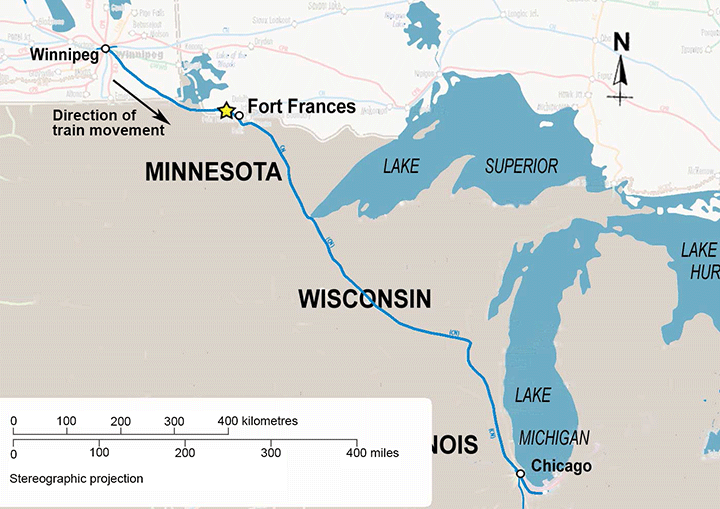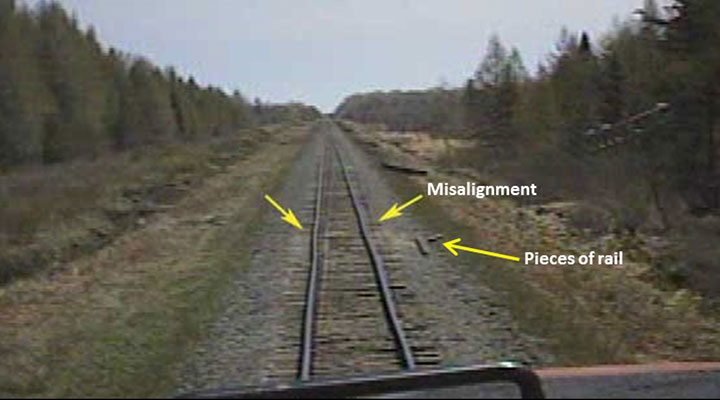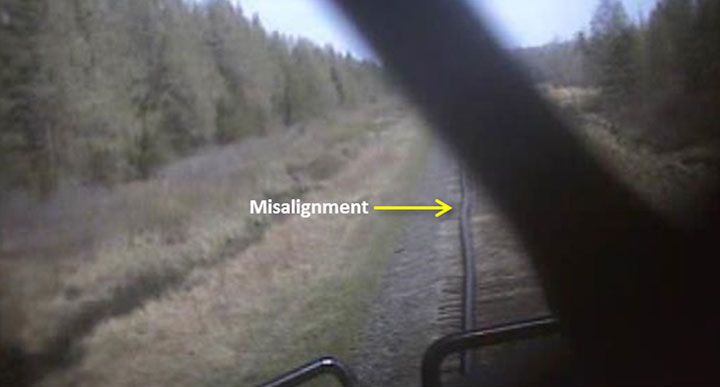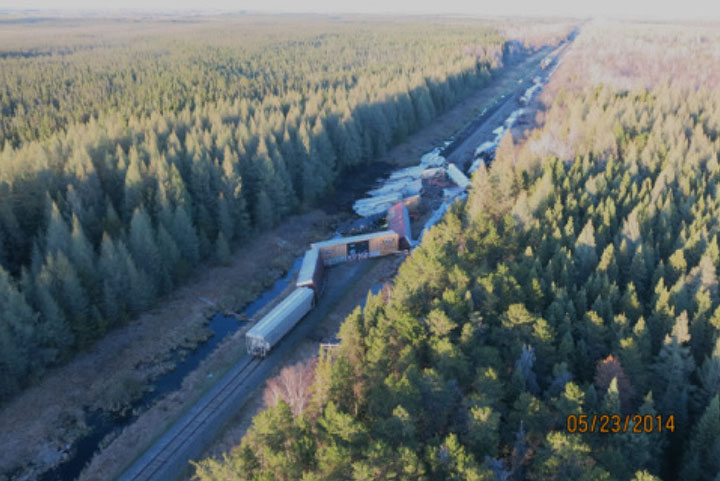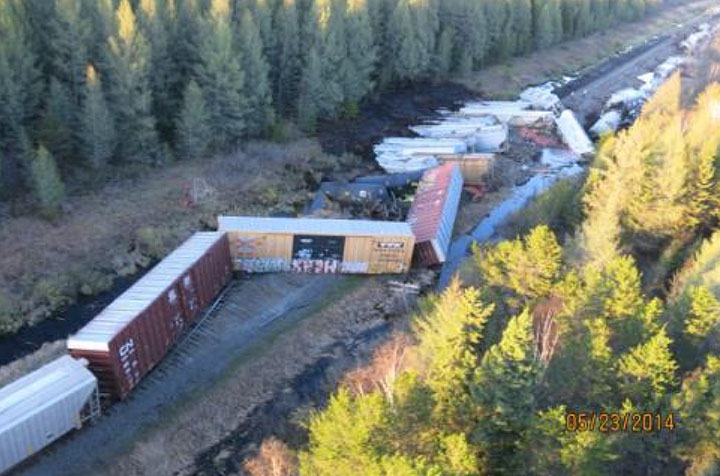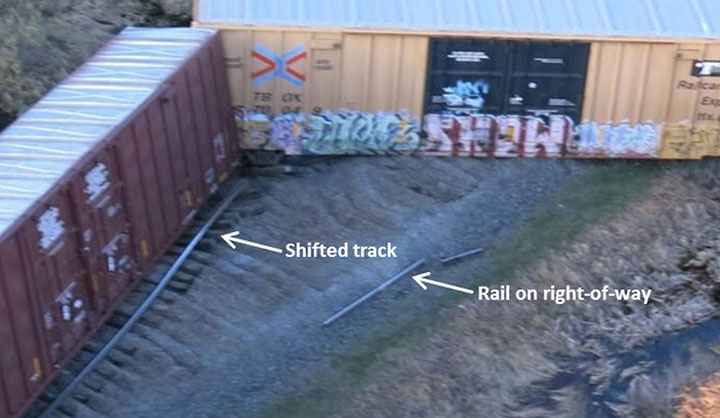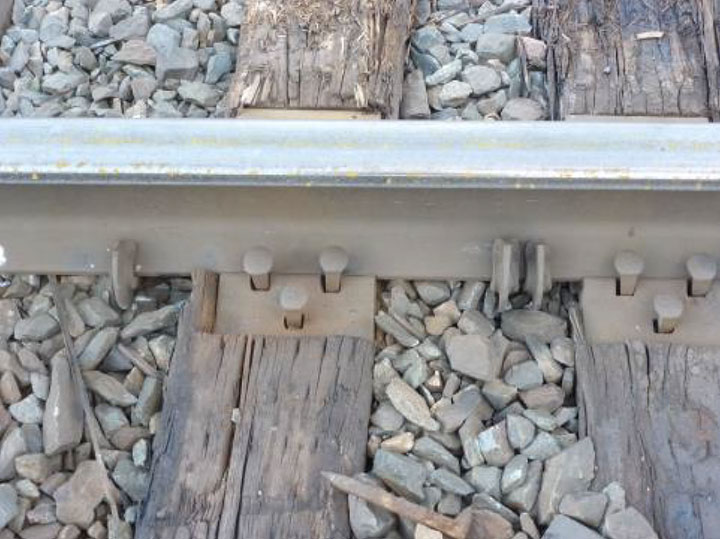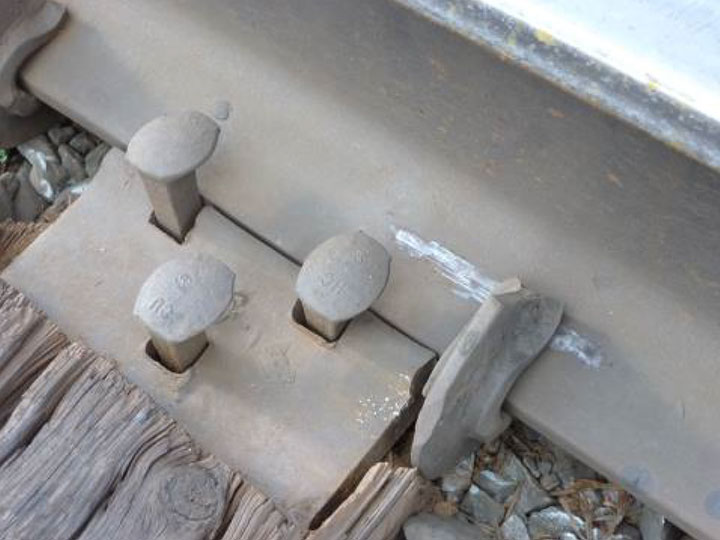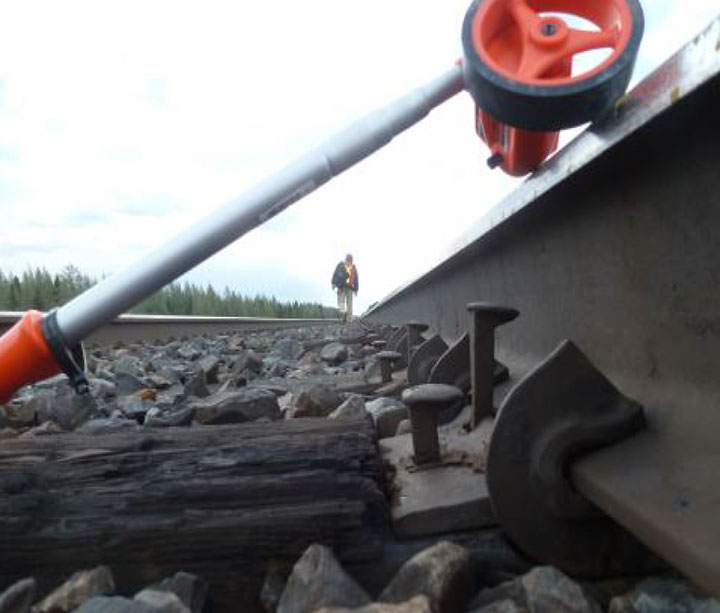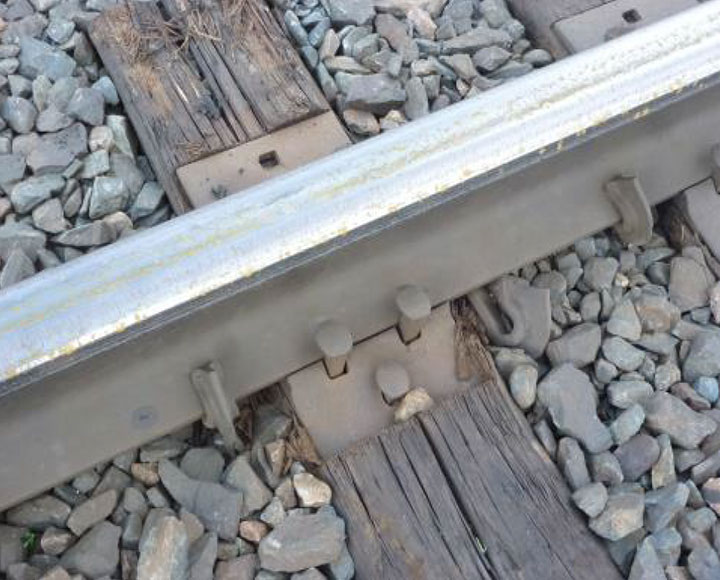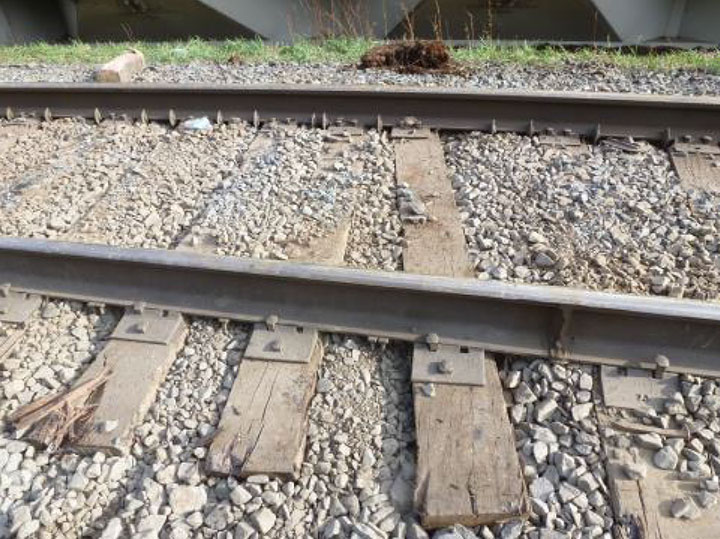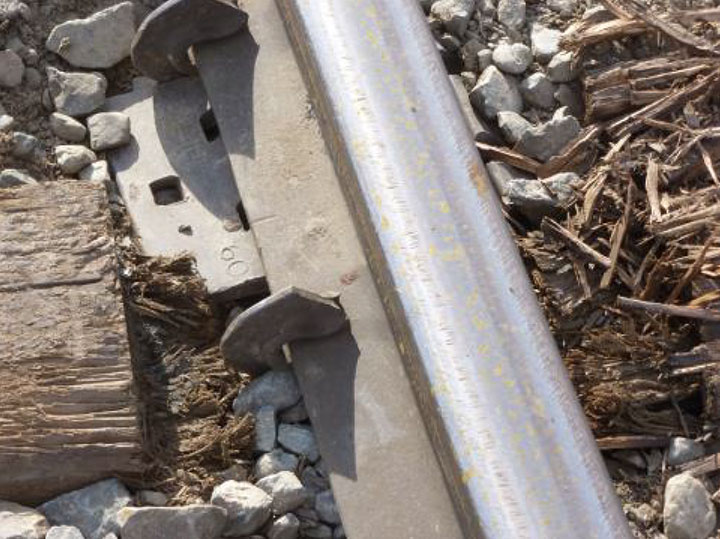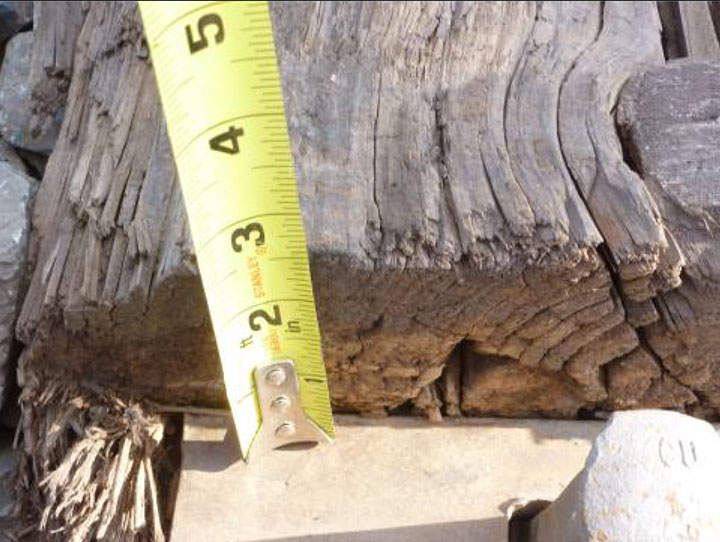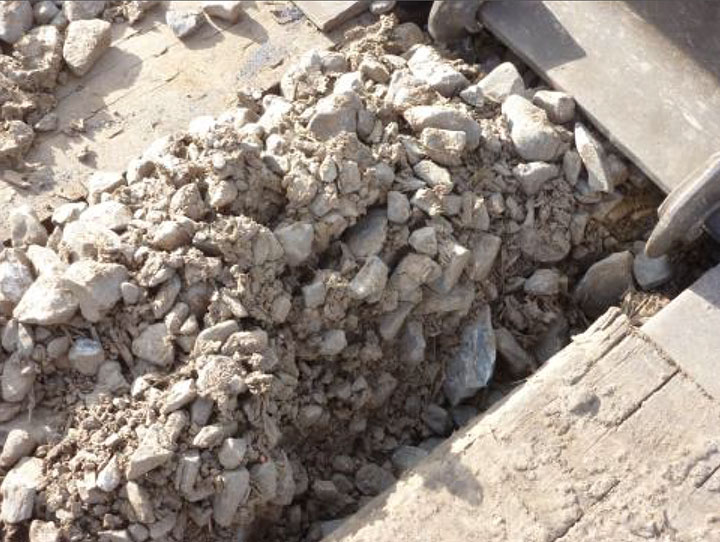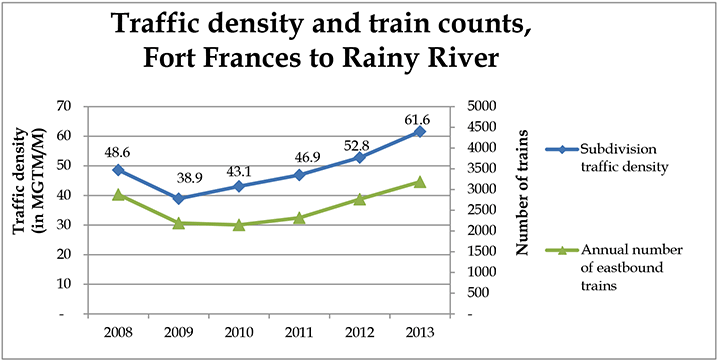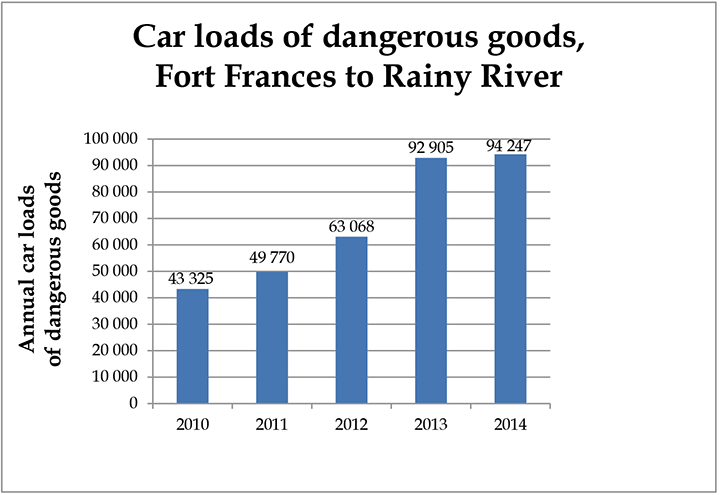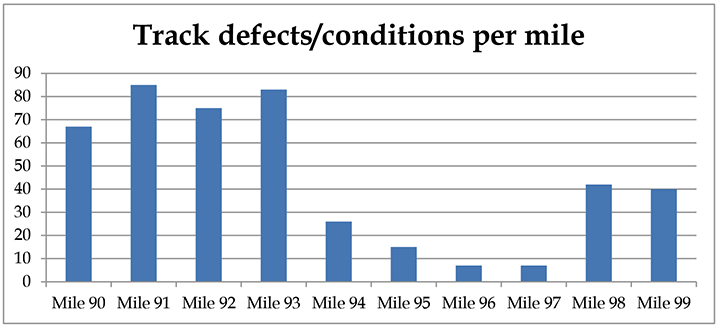Main-track derailment
Canadian National
Freight train M34641-23
Mile 93.38, Fort Frances Subdivision
Fort Frances, Ontario
The Transportation Safety Board of Canada (TSB) investigated this occurrence for the purpose of advancing transportation safety. It is not the function of the Board to assign fault or determine civil or criminal liability. This report is not created for use in the context of legal, disciplinary or other proceedings. See Ownership and use of content. Masculine pronouns and position titles may be used to signify all genders to comply with the Canadian Transportation Accident Investigation and Safety Board Act (S.C. 1989, c. 3).
Summary
On 23 May 2014, at approximately 1408 Central Daylight Time, Canadian National freight train M34641-23 was proceeding eastward on the Fort Frances Subdivision when 35 cars derailed at Mile 93.38 near Fort Frances, Ontario. The derailed cars included 2 tank cars loaded with molten sulphur (UN 2448), 1 of which was punctured and released product. The product ignited a small grass fire that subsequently burned itself out. There were no injuries.
1.0 Factual information
On 23 May 2014, at about 0330,Footnote 1 Canadian National (CN) freight train M34641-23 (the train) departed eastward from Symington Yard in Winnipeg, Manitoba, en route to Chicago, Illinois, United States (Figure 1). The crew consisted of a locomotive engineer and a conductor. Both crew members were qualified for their respective positions, were familiar with the territory, and met established rest and fitness requirements.
The train consisted of 3 locomotives, 119 loaded cars and 45 empty cars. The 164 cars included 21 loaded dangerous good (DG) tank cars and 4 residue tank cars. The train weighed 17 400 tons and was about 9840 feet long. It was operating in a distributed power (DP) configuration powered by 2 head-end locomotives and 1 remote locomotive located behind the 101st car.
While en route from Winnipeg to Fort Frances, Ontario, the train travelled over 9 hot bearing and dragging equipment detectors and 1 wheel impact load detector. No readings exceeding CN's thresholds were recorded for this train.
At 1258 on 23 May 2014, another eastbound CN train, G84042-22 (train G840), was approaching Fort Frances located at Mile 90.2 on the Fort Frances Subdivision. Train G840 was powered by 2 head-end locomotives and consisted of 103 loaded cars and 1 empty car. It weighed 13 990 tons and was about 6270 feet long.
While proceeding at 46 mph on the descending 0.2% grade between Mile 93.0 and Mile 93.5, with the train air brakes released and the dynamic brake (DB)Footnote 2 in position 2, the forward-facing video camera on the lead locomotive of train G840 recorded a slight track misalignment at Mile 93.38 (Photo 1). The locomotive shifted from side to side as it proceeded over the track misalignment.
The crew of train G840 did not take any specific train handling action to operate the train through this location and did not report any unusual track conditions. The temperature at the time was 23.6°C.
1.1 The accident
At 1407 on 23 May 2014, the accident train was descending the 0.2% grade leading into Fort Frances at about 48 mph with the train brakes released. While talking to the rail traffic controller in preparation for the stop at Fort Frances, the crew observed the track misalignment at Mile 93.38. The train crew made a full service application of the automatic train brakes and moved the DB to position 5 just before reaching the track misalignment. About 20 seconds later, the DB was placed in position 8. The forward-facing video camera on the train's lead locomotive recorded the track misalignment (Photo 2). The locomotive shifted from side to side as it traversed the misaligned section of track. Shortly after the train air brakes were applied, a train-initiated emergency brake application occurred and the train slowed to a stop. Subsequent inspection determined that 35 cars had derailed.
At the time of the accident, the sky was clear and sunny. Weather data from Environment Canada's weather station in Fort Frances indicated that the temperature had risen from 2.0°C at 0400 in the morning to 24.7°C at 1400, which was the highest year-to-date temperature recorded.
1.2 Site examination
During site examination, it was determined that the 31st to the 65th cars from the head end had derailed (photos 3 and 4).
Beginning at the west end of the derailment site, the track had shifted to the north (Photo 5). The 65th car came to rest upright, along the track structure in advance of the track panel shift, with only the leading truck derailed. The 64th and 63rd cars from the head end came to rest upright over the portion of track that had shifted north. Two pieces of rail laid along the track shoulders adjacent to the shifted track.
The 46th to 62nd cars were jackknifed across the right-of-way. This group of cars included 2 DG tank cars loaded with molten sulphur (UN 2448). The first of these cars, DVLX 5005, had been struck broadside by the coupler of a following box car, resulting in a release of product. The molten sulphur ignited a small grass fire that extinguished itself.
At the east end of the derailment site, the 31st to 45th car—all covered hopper cars loaded with potash—came to rest on their sides, south of and parallel to the railway right-of-way. The south rail was rolled to the field side. Wheel marks were present on the ties, roadbed, and the web of the south rail. These marks continued eastward beyond the jackknifed cars for about 1000 feet.
During site clean-up, the product in the loaded derailed cars was transshipped. All derailed cars were then scrapped. Approximately 500 feet of track was destroyed and had to be rebuilt.
Just before the derailment site (between Mile 93.5 and Mile 94.0), the track was examined and the following was observed:
- Numerous bundles of new ties were situated along the track right-of-way.
- In a number of locations, anchors were loose, missing, or situated in the centre of the tie crib (i.e., not positioned adjacent to each tie) (Photo 6).
- Spike and anchor abrasion marks were present on the base of the rail, indicating movement of the south rail (Photo 7).
- There were several locations where the spike anchoring of the rail on 3 or 4 consecutive ties was rendered ineffective as there were missing or high spikes (Photo 8) or the tie was spike killedFootnote 3 (Photo 9).
- Many ties were split or skewed as a result of rail movement (Photo 10).
- Both dry rot and wet rot was present on many ties (Photo 11).
- Numerous ties were plate cut between ¾ and 1½ inches (Photo 12). Some were plate cut by up to 2½ inches.
- Over a short section of track containing 100 ties, CN had previously marked 43 ties for removal. During site examination, 60 of the same 100 ties were identified as broken, spike killed or plate cut. Within that section of track, there were 2 locations where 9 or 10 consecutive ties were rendered ineffective by deficiencies in either anchoring or tie condition (i.e. spike killed, broken, split, rotten or skewed).
- The cribs were full and the shoulders ranged from 18 to 24 inches wide. The ballast was composed of 1-inch to 2½-inch angular rock. Beginning from Mile 93.75 and extending eastward to the derailment site, the ballast condition progressively worsened, becoming severely fouled with silt and fine-grained material (Photo 13).
- Water was present in the ditches on both sides of the right-of-way.
1.3 Recorded information
Data from the locomotive event recorder and the forward-facing camera from the lead locomotive were examined (Table 1).
| Time | Mile | Recorded information |
|---|---|---|
| 1404:43 | 95.80 | At the crest of a grade, the throttle handle was in position 8, the train speed was 45 mph, and the air brake pipe pressure was 90 psi. |
| 1407:00 | 94.07 | The throttle was progressively reduced from position 8. The train speed was 47 mph. |
| 1407:38 | 93.56 | The throttle was placed in idle. |
| 1407:40 | 93.53 | DB was applied with the train speed at 48 mph. |
| 1407:43 | 93.47 | At the bottom of the grade, a full service air brake application was initiated. The train speed was 48 mph. The DB handle was in position 5. |
| 1407:54 | 93.34 | The locomotive independent brake was bailed off. |
| 1407:58 | 93.29 | The train speed had decreased to 46 mph. |
| 1408:04 | 93.22 | The DB was placed into position 8. The train speed was 46 mph. |
| 1408:29 | 92.93 | A train-initiated emergency brake application occurred. The train speed was 33 mph. |
| 1408:59 | 92.81 | The head end of the train came to rest. |
1.4 Track information
The Fort Frances Subdivision is a single main track that extends from Mile 0.0 at Atikokan, Ontario, to Mile 143.6 at Rainy River, Ontario. Train movements are governed by the Centralized Traffic Control system, as authorized by the Canadian Rail Operating Rules, and supervised by a rail traffic controller located in Edmonton, Alberta. The track is classified as Class 4 according to the Transport Canada–approved (TC) Rules Respecting Track Safety (TSR).Footnote 4
Between Devlin, Ontario (Mile 101.1), and Fort Frances (Mile 90.2), the track is oriented in an east-west direction and consists of primarily tangent track. The authorized timetable speed for freight trains is 50 mph. Traffic consisted of an average of 11 eastbound and 11 westbound trains per day.
In the vicinity of the accident,
- for eastward train movements, the track generally ascends to a crest at about Mile 95.8, after which it descends into Fort Frances;
- the maximum descending grade is 0.6% between Mile 94.49 and Mile 93.85, after which it reduces to a 0.2% descending grade or less;
- the north rail was 136-pound continuous welded rail (CWR) manufactured in the Czech Republic in 2005 and installed in 2007;
- the south rail was Sydney 132-pound CWR manufactured in 1969/1970 and installed in 1970;
- the rail was laid on 14-inch double-shouldered tie plates secured to hardwood ties with 4 spikes per tie plate and either 2 or 3 gauge side spikes; and
- the rail was box-anchored every tie.
Over the previous 5 years, traffic density in this area had steadily increased from 38.9 million gross ton-miles per mile (MGTM/M) to 61.9 MGTM/M (Figure 2). Train movements in this area were characterized by predominantly loaded trains travelling east and predominantly empty trains travelling west. Since 2010, there had been an increase in eastbound train traffic.
The annual number of car loads of DGs had increased significantly since 2010, reaching 94 247 in 2014, more than doubling the 2010 total of 43 325 (Figure 3).
1.5 Track inspection
Visual track inspections were carried out twice weekly by hi-rail, in accordance with the TSR. The most recent hi-rail inspection had been conducted on 20 May 2014. No exceptions were noted in the vicinity of the derailment. On 23 May 2014, a hot weather patrol had commenced on the west portion of the Fort Frances Subdivision, but did not reach the area east of Mile 101.1 until after the derailment. In April 2014, senior engineering personnel visually inspected a portion of the Fort Frances Subdivision and decided against applying a slow order to the track.
The TSR require that the track geometry be tested twice annually; CN tests it 4 times per year. The most recent geometry car inspection had been performed on 01 May 2014. Urgent gauge, rail cant, warp and cross-level conditions were identified between Mile 92.0 and Mile 94.0. Sections of track within this area were surfaced on 09 May 2014 and again on 17 May 2014. The maintenance-of-way crews had also restored the track gauge.
The TSR require that the rail be tested for flaws at least 4 times per year; CN tests it 13 times per year. The most recent ultrasonic test had been conducted on 06 May 2014. The inspection identified a broken/defective field weld at Mile 93.28 and a crushed head defect at Mile 93.38 of the south rail.
The broken/defective field weld at Mile 93.28 was repaired before the passage of the next train movement. The crushed head at Mile 93.38 was repaired on 22 May 2014, the day before the accident. To repair the crushed head, a section of rail containing the defect and measuring 18.75 feet was removed. After the rail was removed, rail on each side of the opening had expanded about 1½ inches (3 inches in total). A plug rail was prepared to fit the opening. It was then installed and bolted at a rail temperature of 18°C (64°F). The ambient temperature at the time of the plug rail installation was 11°C (52°F).
The inspection results (geometry car, ultrasonic, visual, and ad hoc inspections) for the period between February 2012 and May 2014 indicated that there were 427 track defects and conditions that required monitoring between Mile 90.2 and Mile 99.5 (Figure 4). Of the 427 track defects and conditions, 330 (77%) were from the section of track between Mile 90.2 and Mile 94.0. Excessive cant and narrow gauge conditions accounted for 141 of the 330 (43%). Many of these track defects and conditions had been recurring. For example, all but 26 of the track defects and conditions had been identified during earlier inspections (i.e., identified multiple times). Excessive cant and narrow gauge can be indicators of a deteriorated tie condition.
1.6 Track maintenance
Table 2 provides a summary of the maintenance work completed in the vicinity of the occurrence during the previous year.
| Date | Location (Mile) | Defect/Condition | Rail | Maintenance activity |
|---|---|---|---|---|
| 22 May 2014 | 93.38 | Crushed head | South | An 18.75-foot-long plug rail was installed and bolted at a rail temperature of 18°C (64°F). |
| 21 May 2014 | 93.40 | Rail end batter | South | A 15.00-foot plug rail was replaced with a 14.25-foot plug rail and bolted in place at a rail temperature of 24°C (75°F). |
| 17 May 2014 | 91.90 - 103.86 | Track geometry | A section of 7448 linear feet of track was surfaced. | |
| 15 May 2014 | 91.00 - 93.84 | Tie condition | A total of 67 ties were installed. | |
| 14 May 2014 | 93.00 - 93.47 | Tie condition | A total of 25 ties were installed. | |
| 09 May 2014 | 91.20 - 101.57 | Track geometry | A section of 1911 linear feet of track was surfaced. | |
| 06 May 2014 | 93.28 | Broken/defective field weld | South | The weld was repaired before the passage of the next train. |
| 10 April 2014 | 93.35 | Rail destressing | South | A 16.00-foot section of rail was replaced with a 15.54-foot plug rail and bolted at a rail temperature of 20°C (68°F). |
| 21 Nov. 2013 | 93.40 | Damaged plug rail | South | A damaged plug rail was replaced. |
| 11 Nov. 2013 | 93.40 | Crushed head | South | A 14.75-foot section of rail was replaced with a 15.50-foot plug rail and bolted at a rail temperature of 2°C (36°F). |
| 15 Aug. 2013 | 93.40 | Drainage issue | North | Drainage was improved. |
| 11 July 2013 | 93.40 | Drainage issue | North | Drainage was improved. |
| 12 June 2013 | 93.20 – 93.68 | Track geometry | Track was surfaced. | |
| 11 June 2013 | 93.00 – 93.52 | Track geometry | A section of 1955 linear feet of track was surfaced. |
The section of track extending between Mile 90.1 and Mile 94.5 was generally known to require more attention from the maintenance-of-way personnel.
The last major tie replacement program on the Fort Frances Subdivision had been completed in 2006. Approximately 10 500 ties were replaced between Mile 88.4 and Mile 116.7, 840 of which were between Mile 93.0 and 94.0.
In 2012, CN replaced 2.25 track miles of rail and 2396 ties between Mile 88.2 and Mile 139.25.
In fall 2013, CN had planned to replace 0.41 miles of rail and 4825 ties in a program aimed at breaking up clusters of bad ties. In preparation for the program, the ties in need of replacement were marked and bundles of ties were placed along the right-of-way. However, only 2927 of the planned 4825 ties were installed. Although 585 ties had been allocated for the section of track between Mile 93.0 and Mile 94.0, no ties were installed at that location during the program. In fact, no ties were installed between Mile 90.09 and Mile 102.45, as the workforce and equipment assigned to conduct the tie installation program were unable to obtain track time at this location and were then reassigned to another program.
In 2014, CN had planned to replace 4.98 miles of rail and install 58 800 new ties on the Fort Frances Subdivision. The tie program was originally scheduled for June 2014. However, in spring 2014, it was rescheduled for August 2014 due to competing priorities (i.e., other locations requiring tie programs).
1.7 Regulatory track inspection
As part of its regulatory oversight program, TC conducts periodic track inspections. On the Fort Frances Subdivision, TC's last recorded visual track inspection occurred on 28 August 2012 between Mile 84.0 and Mile 143.6.
During that inspection, the following items were noted:
- Defective ties were present between Mile 87.5 and Mile 87.7, but no track defects were noted between Mile 87.7 and Mile 102.0.
- Between Mile 102.0 and Mile 143.6, poor drainage had resulted in a fouled ballast condition at numerous locations.
Following that inspection, remedial action was undertaken between 27 September 2012 and 19 October 2012.
On 07 August 2013, TC inspected the track between Mile 100.4 and Mile 142.7 on the Fort Frances Subdivision. At various locations between Mile 102.4 and Mile 118.0 and between Mile 131.0 and Mile 135.0, there were poor ballast conditions where water was not being drained adequately through the track structure. At Mile 137.50, a plug rail had a broken head and a loose joint bar. Remedial action was undertaken the same day to repair the rail head and the joint bars. The drainage conditions were remediated by 31 October 2013.
Shortly after this occurrence, TC conducted an urgent inspection of the Fort Frances Subdivision between Mile 109.8 and Mile 128.9. The inspection noted numerous locations where the ties were not effectively supporting the track. To bring the track back into compliance with the TSR, a speed restriction was placed on 3 separate portions of the track. TC noted that CN's inspection of the same locations a few days earlier had not identified and protected against the same track conditions. Based on this information, on 28 May 2014, TC issued a Notice and Order under section 31(2) of the Railway Safety Act restricting train speeds between Mile 90.1 and Mile 142.8 to the maximum allowable for Class 2 track (25 mph for freight trains). TC also ordered CN to have a professional engineer qualified in accordance with section 11 of the Railway Safety Act conduct a track inspection every 30 days and to provide TC with copies of all track inspection reports and remedial actions.
In response to the Notice and Order, CN inspected the track on 29 May 2014. The inspection identified many locations where the ties were in need of replacement and the ballast was fouled. For instance, from Mile 116.5 to Mile 116.98, 14 locations were identified where there were fewer than 12 good ties per 23 consecutive ties (approximately 39 feet). CN repaired some sections of the subdivision. As a result of the inspection and the track repairs, speed restrictions for some sections of track were either raised or removed. Due to poor tie conditions, there was no change to the speed restriction between Mile 90.10 and Mile 94.50.
1.7.1 Transport Canada annual track monitoring program
As part of the track component of TC's annual rail safety program, railways are required to provide TC with a download of rail flaw data. These data are compiled and provided to TC at the end of each year. TC analyses the data for trends that may reflect safety deficiencies. In 2013, TC shared with CN its concerns regarding a significant increase in the number of defective field welds on the Fort Frances Subdivision between Fort Frances (Mile 90.2) and Rainy River (Mile 143.6).
On 06 August 2013, following reports of 8 defective field welds in June 2013, and noting that the number of defective field welds had increased from 25 in 2011 to 88 in 2012, a TC inspector conducted a track inspection and interview. During the interview, CN indicated that the high number of defective welds was, in part, due to false-positive testing errors. Nevertheless, a capital program, involving a major thermite weld program, the installation of 4800 ties, and the replacement of defective rail on tangent track, was scheduled. This capital program was completed by November 2013.
In spring 2014, TC reviewed CN's 2013 defective field weld data for the Fort Frances Subdivision. The data indicated that the number of broken welds in this area remained high. Based on this trend, on 06 May 2014, TC issued to CN a Notice under section 31 of the Railway Safety Act. The notice stated that, in TC's opinion, the high frequency of broken welds represented a threat to safe railway operations. CN was requested to inform TC of the remedial action that CN intended to take.
On 22 May 2014, CN responded to the Notice by confirming the increasing trend in defective welds since 2011 and by indicating that it was increasing its capital expenditures on this subdivision in 2014 to address the trend. CN also indicated that the 2014 defective weld data for the first 5 months showed a decrease, as compared to the same periods in 2013 and 2012. CN believed that this trend would continue in light of the tie renewal program planned for 2014 between Mile 87.0 and Mile 143.0, and the other maintenance activities such as improved rail defect management on tangent track.
1.8 Tie service life
Many factors affect the durability and life of timber ties, including weather conditions, number of trains, tonnage of train traffic, tie size, track curvature, as well as treatment of the ties during manufacturing. In areas with significant train traffic, the mechanical action of repeated load cycles from moving trains can be a major determinant of tie service life. A study of tie service life for major United States Class I railroadsFootnote 5 determined that, independent of other factors, the expected service life is between 20 and 30 years when the annual traffic level is between 5 and 30 million gross tons (MGT). Service life drops below 20 years when annual traffic levels are over 38 MGT. Tie service life can decrease to 15 years (or less) when annual traffic levels exceed 50 MGT.
Tie deterioration over time is non-linear, normally with little loss of usefulness in the first two thirds to three quarters of its life. However, once wood fibres begin to break down, further deterioration can be rapid. On heavy-tonnage lines, once ties display signs of deterioration, tie replacement may be required within 1 to 2 years.
1.9 Track buckles
A track buckle is a lateral shift of the track that occurs when longitudinal compressive stresses in the rail overcome the lateral resistance of the track structure. Track buckles can occur when there is an increase in the longitudinal compressive stress or when there is a decrease in the lateral resistance of the track structure.
To lower the risk of track buckling, CWR is normally installed at a temperature close to the preferred rail laying temperature, which is 90°F (32°C) for Canadian subdivisions. At that temperature, which constitutes the neutral temperature of the rail, the rail is considered to be stress-free (i.e., not subjected to either compressive or tensile forces). Whenever the temperature of the CWR exceeds the neutral temperature, longitudinal compressive stresses increase.
The neutral temperature of the rail can change over time. High or low ambient air temperatures, track maintenance and traffic-induced movements can cause a redistribution of the internal stresses in the rail, thus modifying the neutral temperature. When the neutral temperature of the rail is lowered, it can lead to zones of tight rail, and the temperature at which a track can buckle is lowered.
Zones of tight rail can develop at locations such as at the bottom of descending grades where trains descending the grade regularly use braking to control train speed. The formation of these zones becomes more likely with the passage of long, heavy trains or when the track and track structure are not well maintained.
In CWR, track buckles can occur on both curves and tangent track. Signs that point towards an increased risk of track buckles include
- rail anchors that have moved away from the tie;
- marks present on the base of the rail where the rail has moved through the spikes;
- recent tie movement and the bunching of ties in the ballast;
- clusters of poor ties that often have high spikes; and
- extremely “kinky” rail that is riding up or out of the tie plates.
In addition to these signs, locations that may be prone to track buckles include
- areas of known heavy brake application such as on steep grades; and
- locations of soft subgrade such as swamps, bogs or muskegs where the rail moves excessively under traffic, causing ties to skew and bunch up.
To prevent the development of zones of tight rail in CWR, the rail must be properly supported and secured. Restraining the rail longitudinally and laterally in the track is dependent upon having sound ties, sufficient spikes and anchors,Footnote 6 and clean crushed rock ballast. If one or more of these track components are not contributing to the expected resistance to these forces, the potential for a track buckle increases. Knowledge of the rail-neutral temperature is critical to the maintenance of rail and to managing the risks of track buckles.
1.10 Canadian National's Engineering Track Standards
CN's Engineering Track Standards (ETS) set out maintenance standards and practices to be employed on all trackage and rights-of-way owned by CN and its affiliated North American railways. These standards are “intended as guidelines and not meant to replace or super[s]ede the Federal Railroad Administration (FRA) Track Safety Standards or Transport Canada (TC) Track Safety Rules.”
The ETS contain detailed information on the installation and maintenance of CWR, including the steps required to prevent track buckling.
Section TS 1.3, Continuous Welded Rail (CWR), of CN's ETS states in part:
- When any of the following are apparent: bunched or pushing ties which are plowing ballast, rail running either through rail anchors or with the anchors, rail lifting up under the spike heads, rail pushing against both shoulders of the tie plates, canting rail on curves, gaps at the ends of the ties indicating lateral movement of the track or track having a kinky alignment immediate remedial action will be taken by either placing a speed restriction or adjusting the rail.
Section TS 2.0, Timber Tie Installation and Maintenance, of CN's ETS states in part:
- In preparation for a tie renewal program:
[...]
- The following definitions of defective ties will be used:
- Broken Tie - Tie that is broken through the entire depth of the tie.
- Split Tie - Tie split end to end for the entire depth of the tie.
- Split Tie End - Tie end split into the spike holes, or split full depth and wide enough to permit ballast to come through, resulting in poor surface and gauge.
- Cut Tie - Tie that is rail or plate cut or adzed to a depth of 2” or more on No. 1 ties, or 1” or more on No. 2 ties.
- Crushed Tie - Tie that has the bearing surface under the rail crushed or splintered, 1” or more, to the extent that it cannot hold surface, line or gauge.
- Spike Killed Tie - Condition may be indicated by numerous splits at the tie end, loose or high spikes, rail or plate movement of more than 1/2” or wide gauge (including dynamic wide gauge).
- Decayed Tie - Tie that is decayed and cannot hold spikes, gauge or surface.
- Damaged Tie - Tie that has been damaged by derailment, dragging equipment, or fire to the extent that it cannot hold surface, line or gauge.
- Worn Tie - A tie worn or rounded on the bottom from movement of the tie in the ballast, resulting in poor surface and line and an inability to hold spikes.
Furthermore, according to the ETS, the number of non-defective ties in any 39-foot length of track shall never be less than 12 for Class 4 track with a curvature up to 2 degrees. Also, a spot renewal program should be undertaken when there is a high frequency of 4 or more consecutive defective ties on track with a curvature up to 2 degrees.
Section TS 3.0, Tie Plates, of the ETS states that, for any Class 3 to Class 6 track with 0 degree to 2 degrees of curvature and greater than 40 MGT of annual traffic, 16-inch tie plates with a 6-inch rail base are recommended.
1.11 Canadian National's best practices train handling guide for long distributed power trains on the Fort Frances Subdivision
Long DP trains had been operating on the Fort Frances Subdivision for several years before this occurrence. Operation of this type of train often requires forward planning by the locomotive engineer to avoid excessive in-train forces. CN's best practices train handling guide is designed to help keep in-train forces to a minimum.
The best practices train handling guide provided to train crews include the following:
- Approaching Fort Frances from an eastward direction, crews could control train speed using DB entering the 0.6-degree descending grade at Mile 94.5 to beyond the Fort Frances west siding switch at Mile 90.1.
- The automatic brake could be used from about Mile 90.9, approaching the west end of the Fort Frances siding where the signalled siding speed is 25 mph and the main track speed is reduced to 40 mph or in preparation for meets with other trains or switching activities.
However, CN has no guidelines for locomotive engineers on train handling strategies when encountering a suspected track buckle or track misalignment. Rather, locomotive engineers are left to draw upon their own experience.
1.12 Track Safety Rules and inspections
The TSR prescribe the minimum safety requirements for railway track that is part of the general railway system of transportation. Part II, Subpart A, establishes the maximum allowable operating speeds (in mph) for various classes of track (Table 3).
| Over track that meets all of the requirements prescribed in this part for |
The maximum allowable operating speed (mph) for freight trains is |
The maximum allowable operating speed (mph) for passenger trains is |
|---|---|---|
| Class 1 track | 10 | 15 |
| Class 2 track | 25 | 30 |
| Class 3 track | 40 | 60 |
| Class 4 track | 60 | 80 |
| Class 5 track | 80 | 95 |
Part II, Subpart D, details the safety requirements for the track structure. Section II, dealing with cross ties, states in part:
[…]
(c) Each 39 foot segment of:
[…]
- Classes 4 and 5 track shall have 12 crossties, which are not:
- broken through;
- split or otherwise impaired to the extent the crossties will allow the ballast to work through, or will not hold spikes or rail fasteners;
- so deteriorated that the tie plate or base of rail can move laterally more than ½ inch relative to the crossties; or
- cut by the tie plate through more than 40 percent of a tie's thickness.
1.13 Key route risk assessment
As a result of the TSB Lac-Mégantic investigation (R13D0054), the Board was concerned with the level of safety surrounding the transportation of DGs (Appendix A). On 23 January 2014, the Board recommended that
The Department of Transport set stringent criteria for the operation of trains carrying dangerous goods, and require railway companies to conduct route planning and analysis as well as perform periodic risk assessments to ensure that risk control measures work.
Transportation Safety Recommendation R14-02
In response to that recommendation, TC issued an Emergency Directive (ED) on 23 April 2014, identifying the measures that railways must implement to strengthen the safety system for the transportation of DGs. Included in the list of measures was the requirement that railways conduct a risk assessment of all key routes over which key trains operate. The ED also identified the factors that the risk assessment must consider. At the same time, TC issued a Ministerial Order requiring railways to formulate rules respecting the safe and secure operations of trains carrying certain DGs and flammable liquids. For the ED and the Ministerial Order, key routes and key trains were defined as
“Key Train” means an engine with cars:
- that includes one or more loaded tank cars of dangerous goods that are included in Class 2.3, Toxic Gases and of dangerous goods that are toxic by inhalation subject to Special Provision 23 of the Transport of Dangerous Goods Regulations; or
- that includes 20 or more loaded tank cars or loaded intermodal portable tanks containing dangerous goods, as defined in the Transportation of Dangerous Goods Act, 1992 or any combination thereof that includes 20 or more loaded tank cars and loaded intermodal portable tanks.
“Key Route” means any track on which, over a period of one year, is carried 10,000 or more loaded tank cars or loaded intermodal portable tanks containing dangerous goods, as defined in the Transportation of Dangerous Goods Act, 1992 or any combination thereof that includes 10,000 or more loaded tank cars and loaded intermodal portable tanks.
In August 2013, the portion of the Fort Frances Subdivision between Duluth Junction, Mile 88.1, and Rainy River, Mile 143.6, was identified as a key route. This portion of the subdivision was included in the corridor risk assessment for the Chicago-Winnipeg route. CN reviews rail traffic volumes of DG cars annually to determine changes in key route status.
The Chicago–Winnipeg corridor extends between Kirk Yard in Gary, Indiana, United States, and Symington Yard in Winnipeg, Manitoba. This corridor provides the vital link between western Canada and the United States Midwest and South. The route is made up of 9 subdivisions.
CN has processes in place for identifying track infrastructure maintenance. For example, rail traffic volumes and detailed track defect analyses are used to identify the need for upgrades through a capital program. CN's methodology includes the review of traffic volumes, class of track and inspection frequencies for track geometry testing and for rail flaw detection testing. When trends emerge, CN may adjust the inspection frequencies as required.
The most recent risk assessment for the Chicago-Winnipeg corridor was completed on 03 April 2014 as part of an initiative to carry out proactive reviews of railway corridors with a focus on higher-risk areas such as population centres and waterways. This risk assessment met the requirements of TC's Ministerial Order of 23 April 2014. The factors considered in the risk assessment included DG train accident locations, populated areas, water bodies, bridges and structures, other transportation facilities, passenger train stations and cultural facilities. The applicability of risk-mitigating procedures and technologies was reviewed for each track segment along the corridor. Track segments with residual risk were identified. Additional risk-mitigating strategies were then proposed.
For the Fort Frances Subdivision, the risk assessment recommended the installation of an additional clearance detector at Rainy River to protect a bridge from shifted loads. The risk assessment did not, and was not required to, identify the deteriorated track condition and the deferred maintenance as areas of emerging risk for this corridor. This was typically undertaken during CN's Engineering Department's planning processes.
1.14 Other related occurrences
Since 2002, the TSB has recorded 8 other derailments where track infrastructure failure and track maintenance activities played a role in the accident (Appendix B).
2.0 Analysis
The condition of the rolling stock was reviewed and no defects were found that were considered contributory to the accident. The recordings from the forward-facing video cameras of the occurrence train and of an earlier train identified a slight track misalignment condition at Mile 93.38. The analysis will focus on factors that contributed to the formation of the track misalignment and the subsequent track buckle, including Canadian National (CN) track maintenance, train handling, and regulatory oversight.
2.1 The accident
The accident occurred when the track misalignment at Mile 93.38 buckled sharply beneath the train, leading to the derailment of the 31st to 65th cars. The track structure in the vicinity of the derailment was in poor condition with skewed and defective ties, fouled ballast and ineffective anchoring of the rail. In a weakened state, the track structure could not prevent the rail from creeping eastward or from shifting laterally.
The track structure is expected to withstand train forces due to the use of dynamic braking (DB) and full service and/or emergency brake applications. In this occurrence, the forces imparted into the track by the train could not be contained by the weakened track structure. Traffic over the Fort Frances Subdivision had increased in recent years. This traffic included predominantly heavier loaded eastbound trains and lighter empty westbound trains. It was common practice for the heavier eastbound trains to have their brakes applied while descending the grade into Fort Frances. While operating on the weakened track structure, the braking action of heavier eastward trains descending into Fort Frances induced rail creep, which increased the longitudinal compressive forces on the rails near Mile 93.38, lowering the rail-neutral temperature. The highest year-to-date ambient temperature was recorded on the day of the accident. With a large temperature change that day, there was a further increase in the compressive stress within the rails.
In continuous welded rail (CWR) territory, rail creep is indicative of the redistribution of stress within the rail, which lowers the rail-neutral temperature. The work performed on the south rail the day before the derailment identified that the rail-neutral temperature at this location was significantly lower (64°F or 18°C) than the preferred rail laying temperature of 90°F (32°C). Moreover, when the rail containing the crushed head defect was removed from the south rail, compressive stress in the south rail was released. An imbalance in stress levels between the north and south rails resulted, making the track more susceptible to lateral deflection.
2.2 Train handling
As there were no train handling guidelines issued by the company for approaching a track misalignment, train crews relied on their own judgement and experience when encountering these track conditions. There had been no report of rough track from the previous train (train G840) crew members, as they had passed over the location without incident. Subsequently, with the M346 train crew members initially unaware of the track misalignment, there was no opportunity to plan their train handling over this location. The train approached and passed over the track misalignment with the DB on and the train automatic air brakes fully applied. Although the train was handled in accordance with company guidelines, the application of train DB and automatic air brakes in advance of the track misalignment imparted additional compressive forces into an already weakened track structure. With each passing car, the track misalignment increased until the track buckled beneath the train. However, CN has no train handling guidelines for traversing track misalignments.
2.3 Track maintenance
Since 2008, the amount of traffic on the Fort Frances Subdivision had steadily increased, exceeding 60 million gross ton-miles per mile (MGTM/M) in 2013. The railway industry recognizes the impact that the operation of large tonnages of traffic can have on the condition and wear rate of track structures. As a result, track standards have been developed with an increased requirement for inspections to support such traffic.
The track structure in the vicinity of the derailment had been rapidly degrading over the previous 2 years. Since 2012, the section of track from Mile 90.2 to Mile 94.0 had been experiencing recurring defect conditions, such as excessive rail cant and narrow gauge. These types of condition are related to tie deterioration. In 2013, on the Fort Frances Subdivision, CN experienced a significant increase in broken field welds between Mile 101.0 and Mile 144.0. This condition is also linked to tie deterioration. For at least 12 months before the occurrence, CN had been aware of the rail creep and the poor condition of the track in the vicinity of the derailment.
CN had planned to improve the track with a tie replacement program scheduled for fall 2013, followed by another tie replacement program scheduled for June 2014. The 2013 program was only partially completed and the 2014 program was delayed until August 2014. The improvements necessary to maintain the track to Class 4 standards were not fully completed. The already weakened track structure continued to deteriorate as rail traffic and tonnage increased. Despite an increase in rail traffic and tonnage, track maintenance programs were delayed on track that was already showing signs of deterioration, and no mitigation strategies such as speed reductions were applied.
Although CN's Engineering Track Standards (ETS) identify the conditions that require remedial action, the application of these standards often required a subjective interpretation. In some cases, protective action did not always result. With an increasing amount of traffic on the Fort Frances Subdivision, any protective action such as speed restrictions would have negatively affected the flow of traffic. Notwithstanding, CN's ETS were not consistently applied. Without proper maintenance and restoration activities, the track condition near Mile 93.38 worsened until the track could no longer restrain the normal operating forces imparted by train brakes and the temperature-related compressive forces that had built up within the rail.
2.4 Regulatory overview and enforcement
Before the accident, Transport Canada's (TC) last recorded visual track inspection in the vicinity of the derailment was conducted on 28 August 2012. Defective ties were noted between Mile 87.5 and Mile 87.7, but no track defects were noted between Mile 87.7 and Mile 102.0. Given that CN was aware of the deteriorating ties throughout the subdivision and had planned tie renewals for 2013 and 2014, it is likely that the track was exhibiting signs of deterioration at the time of the TC inspection in 2012.
The Rules Respecting Track Safety (TSR) and CN's ETS require that, if track defects or conditions are not adequately repaired or monitored, a slow order must be applied to reduce train speeds in that area of track. In this case, neither was done. Despite the deteriorated condition of the track before the accident, CN determined that the track was safe for Class 4 track speeds. Shortly after the derailment, TC inspected the Fort Frances Subdivision and placed speed restrictions on parts of the subdivision, lowering the track speed from Class 4 (60 mph) to Class 2 (25 mph). CN's post-accident inspection also identified a number of locations that required speed reductions, including the track in the vicinity of Mile 93.38. Despite CN's company maintenance and TC's regulatory inspection activities before the accident, the weakened track structure was not being adequately repaired or being protected by slow orders.
Following the accident, TC also ordered CN to have a track inspection conducted by a professional engineer qualified in accordance with section 11 of the Railway Safety Act every 30 days and to provide copies of all track inspection reports and remedial actions. Such enforcement action often follows a major derailment. TC had been generally aware of the condition of the Fort Frances Subdivision, as the increasing number of broken welds had been highlighted. In discussions with CN, TC had been informed that CN would be implementing a number of tie replacement programs to improve the track condition. However, the condition of the track was not restored as the tie replacement programs were not fully completed or were further delayed.
Maintenance programs must be implemented in a timely manner to ensure that risks are adequately mitigated. In this occurrence, the condition of the Fort Frances Subdivision degraded to that of Class 2 track without having a corresponding reduction in speed initiated by the company or through regulatory enforcement. Following the accident, on 28 May 2014, TC provided a Notice and Order to CN restricting speeds between Mile 90.2 and Mile 142.8 to 25 mph. If TC inspection and enforcement activities do not ensure that timely maintenance action is taken when track deterioration is evident, the risk of deteriorating track infrastructure leading to derailment is increased.
2.5 Track maintenance on key routes
CN's route risk assessment methodology reviews traffic volumes, class of track and inspection frequencies for track geometry testing and for rail flaw detection testing. When trends emerge, CN may adjust the inspection frequencies as required. In addition, rail traffic volumes and detailed track defect analyses are used to identify the need for upgrades through a capital program. Despite these measures, the track conditions on the Fort Frances Subdivision continued to deteriorate, resulting in a derailment.
The track on the Fort Frances Subdivision met the criteria for a key route and was therefore subject to additional safety measures, including the requirement for a formal risk assessment and mitigating strategies. While CN's risk assessment for this corridor and its engineering processes took into account a number of factors, the mitigating strategies in place were insufficient. For example, the risk assessment did not consider, nor was it required to consider, the situation where the required maintenance programs would be delayed. In this occurrence, during the delay, rail traffic and tonnage increased and the track deteriorated more rapidly to the point where it did not meet Class 4 standards. Although CN was aware of the deteriorating track condition, trains on the subdivision continued to operate at speeds up to 60 mph (i.e., Class 4).
Key routes require additional risk assessments due to the hazards that are present on trains that travel over the corridor. Because of these hazards, the risk of adverse consequences due to the release of product during a derailment is increased. In this occurrence, track maintenance was deferred and the mitigating strategies in place did not sufficiently reduce the risk. Although the train involved was not a key train, there was potential for an even more serious accident to occur. If key route corridor risk assessments do not consider when capital programs are delayed and deferred, the track can continue to deteriorate rapidly, increasing the risk for track-related derailments.
3.0 Findings
3.1 Findings as to causes and contributing factors
- The accident occurred when the track misalignment at Mile 93.38 buckled sharply beneath the train, leading to the derailment of the 31st to 65th cars.
- The track structure in the vicinity of the derailment was in poor condition with skewed and defective ties, fouled ballast and ineffective anchoring of the rail.
- While operating on the weakened track structure, the braking action of heavier eastward trains descending into Fort Frances induced rail creep, which increased the longitudinal compressive forces on the rails near Mile 93.38, lowering the rail-neutral temperature.
- The highest year-to-date ambient temperature was recorded on the day of the accident. With a large temperature change that day, there was a further increase in the compressive stress within the rails.
- When the rail containing the crushed head defect was removed from the south rail, compressive stress in the south rail was released. An imbalance in stress levels between the north and south rails resulted, making the track more susceptible to lateral deflection.
- Although the train was handled in accordance with company guidelines, the application of train dynamic brake and automatic air brakes in advance of the track misalignment imparted additional compressive forces into an already weakened track structure. With each passing car, the track misalignment increased until the track buckled beneath the train.
- Despite an increase in rail traffic and tonnage, track maintenance programs were delayed on track that was already showing signs of deterioration, and no mitigation strategies such as speed reductions were applied.
- Canadian National's Engineering Track Standards were not consistently applied. Without proper maintenance and restoration activities, the track condition near Mile 93.38 worsened until the track could no longer restrain the normal operating forces imparted by train brakes and the temperature-related compressive forces that had built up within the rail.
- Despite Canadian National's company maintenance and Transport Canada's regulatory inspection activities before the accident, the weakened track structure was not being adequately repaired or being protected by slow orders.
3.2 Findings as to risk
- If Transport Canada inspection and enforcement activities do not ensure that timely maintenance action is taken when track deterioration is evident, the risk of deteriorating track infrastructure leading to derailment is increased.
- If key route corridor risk assessments do not consider when capital programs are delayed and deferred, the track can continue to deteriorate rapidly, increasing the risk for track-related derailments.
3.3 Other findings
- Canadian National has no train handling guidelines for traversing track misalignments.
4.0 Safety action
4.1 Safety action taken
On 28 May 2014, Transport Canada (TC) issued a Notice and Order under the authority of section 31 of the Railway Safety Act. The order restricted Canadian National (CN) in the following manner:
- Trains operating between Mile 90.1 and Mile 142.8 on the Fort Frances Subdivision were limited to speeds not greater than the maximum speeds allowed for Class 2 track until the track was inspected and deemed safe for railway operation by a professional engineer.
- A professional engineer was required to inspect the track every 30 calendar days and confirm that it was safe for railway operations.
- TC was to be provided with copies of all track inspection reports, including remedial actions, within 14 days of completing each inspection.
On 29 May 2014, CN conducted a walking inspection with 8 professional engineers. As a result of the inspection and subsequent track repairs, speed restrictions for some sections of the track were either raised or removed.
On 10 June 2014, 2 tie gangs were mobilized to the Fort Frances Subdivision and began installing ties. The gang replaced ties between Mile 87.0 and Mile 143.6.
On 24 July 2014, TC completed its review and evaluation of the corrective measures undertaken by CN. The actions were deemed to satisfactorily address the unsafe conditions noted, and the Notice and Order was revoked.
This report concludes the Transportation Safety Board's investigation into this occurrence. The Board authorized the release of this report on 9 March 2016. It was officially released on 16 March 2016.
Appendices
Appendix A – Lac-Mégantic accident
On 05 July 2013, at about 2250 Eastern Daylight Time, Montreal, Maine & Atlantic Railway (MMA) freight train MMA-002, en route from Montréal, Quebec, to Saint John, New Brunswick, was stopped at Nantes, Quebec (Mile 7.40 of the Sherbrooke Subdivision), which was the designated MMA crew-change point. The train, consisting of 5 head-end locomotives, 1 VB car (i.e., special-purpose caboose), 1 box car, and 72 Class 111 tank cars carrying flammable liquids (petroleum crude oil, UN 1267, Class 3), was secured on the descending grade of the main track, and then left unattended.
Shortly before 0100 on 06 July 2013, the unattended train started to move and gathered speed as it rolled uncontrolled down the descending grade towards the town of Lac-Mégantic, Quebec. Sixty-three Class 111 tank cars and the box car derailed near the centre of the town. The derailed cars released approximately 5.98 million litres of product that ignited almost immediately. The resulting fire burned for more than a day. Forty-seven people were fatally injured. Many buildings, vehicles, and the railway tracks were destroyed.
Appendix B – Other related occurrences
Since 2002, TSB has recorded 8 other derailments where infrastructure failure and track maintenance activities played a role in the accident.
TSB Report R02C0054 (Carstairs, Alberta) – On 23 July 2002, Canadian Pacific Railway southward freight train 771-23 derailed 15 loaded tank cars at Mile 36.6 of the Red Deer Subdivision. The track bed was in a weakened state. The rail anchors were either loose or missing, and were not sufficient to prevent rail creep. The ballast was fouled with sandy silt material, the shoulders had fallen away and the ties were skewed. Surfacing the track disturbed the ballast and reduced its lateral strength. As the train passed over the weakened section of track, the compressive stresses were further increased, causing small deviations, or kinks, to occur in the rail. With each passing car, the deviations increased until the track shifted sharply and buckled, causing the train to derail.
TSB Report R04T0161 (Burton, Ontario) – On 25 July 2004, Canadian National (CN) intermodal freight train Q11131-25 derailed 45 car bodies at Mile 185.50 of the Bala Subdivision near Burton, Ontario. The train derailed when the 15th car, DTTX 750219, rolled the low rail at Mile 184.38 on the 5-degree portion of a right-hand compound curve. Five factors, including wheel/rail friction and contact, track fastening method, car cornering characteristics, and track alignment, contributed to the derailment. Recent track maintenance involved installing 16-inch tie plates and elastic fasteners on the high rail. The standard cut spikes and 14-inch tie plates installed on the low rail had remained.
TSB Occurrence R06T0125 (South Parry, Ontario) – On 06 June 2006, CN intermodal freight train Q10251-02 derailed at Mile 147.60 of the Bala Subdivision, at the north South Parry siding switch. There was a mix of tie fastening systems used in the curve (i.e., elastic fasteners on the high rail and spikes on the low rail). The 6th car, a multi-platform car, derailed when the low rail on the 6-degree left-hand curve canted. The L4 wheel (trailing wheel, low side) dropped in, and subsequent wheels followed.
TSB Report R06T0153 (Mimico, Ontario) – On 14 July 2006, CN westward freight train A43531-14 derailed 7 cars at Mile 6.0 of the Oakville Subdivision. The train derailed when the track buckled under the train as it passed over the turnout where the rail was not restrained with box anchors after the turnout was installed.
TSB Report R07D0030 (Huntingdon, Quebec) – On 29 March 2007, CN freight train M32721-28 derailed 8 cars at Mile 202.51 of the CSX Montréal Subdivision. The rail was sporadically anchored and there were multiple clusters of ties with no anchors. Some of the anchors were not effective as they had moved away from the ties. Consequently, the rail was not restrained longitudinally and was free to move. In the absence of adequate rail anchoring, the heavy southward traffic, combined with train braking on the downward grade, caused the rail to move southward and bunch, increasing the compressive stress in the rail. Moreover, the addition of 9 inches of rail on the east rail, which was scheduled for removal before the onset of hot weather, had increased the compressive stresses and contributed to the development of the track buckle. Transport Canada was aware of the poor rail anchoring condition before the derailment.
TSB Report R07T0323 (Malport, Ontario) – On 30 October 2007, eastward CN freight train number M38461-29 derailed a number of cars under braking on tangent track at Mile 9.30 of the Halton Subdivision, a location where trains regularly stop to set off cars. It was determined that the 100 track ties just west of the point of derailment were in marginal condition with a 41% failure rate.
TSB Report R11T0162 (Waterfall, Ontario) – On 14 July 2011, CN freight train Q10251-10 derailed 11 multi-platform intermodal cars at Mile 243.10 of the Bala Subdivision near Waterfall, Ontario. When gauging was performed in 2009, the high rail in the curve was secured with 6 or 7 spikes per tie plate, but the low rail continued to be secured to 14-inch tie plates using only 4 spikes per plate. Based on traffic volumes, the company standards warranted the use of 16-inch tie plates. With this spike pattern, the low rail's resistance to rail rotation and gauge widening was less than CN track standards and significantly less as compared to the resistance of the high rail. Tie-replacement and track-gauging activities can lead to localized, increased dynamic gauge widening if equal attention is not given to the securement of both rails.
TSB Report R14E0081 (Faust, Alberta) – On 11 June 2014, eastbound CN freight train A41851-11 derailed the last 20 cars at Mile 202.3 of the Slave Lake Subdivision, near Faust, Alberta. Approximately 1200 feet of track was damaged. The derailment occurred when the track shifted laterally under the passing train. The track buckle occurred due to the irregular rail anchoring pattern, a build-up of compressive stress in the rail and a relatively unstable peat subgrade that was unable to restrain the longitudinal forces generated by the train descending the grade.
